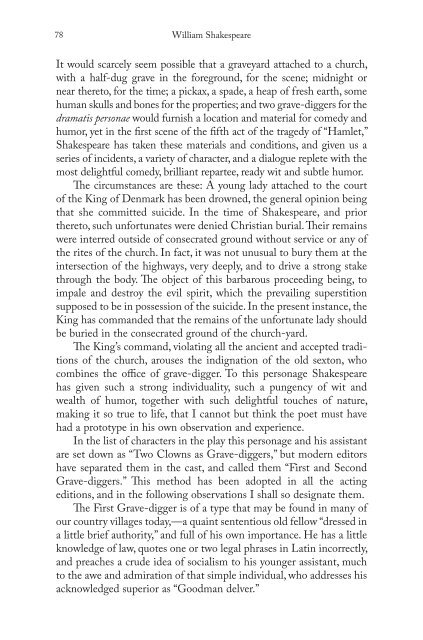Blooms Literary Themes - THE TRICKSTER.pdf - ymerleksi - home
Blooms Literary Themes - THE TRICKSTER.pdf - ymerleksi - home
Blooms Literary Themes - THE TRICKSTER.pdf - ymerleksi - home
You also want an ePaper? Increase the reach of your titles
YUMPU automatically turns print PDFs into web optimized ePapers that Google loves.
78<br />
William Shakespeare<br />
It would scarcely seem possible that a graveyard attached to a church,<br />
with a half-dug grave in the foreground, for the scene; midnight or<br />
near thereto, for the time; a pickax, a spade, a heap of fresh earth, some<br />
human skulls and bones for the properties; and two grave-diggers for the<br />
dramatis personae would furnish a location and material for comedy and<br />
humor, yet in the fi rst scene of the fi fth act of the tragedy of “Hamlet,”<br />
Shakespeare has taken these materials and conditions, and given us a<br />
series of incidents, a variety of character, and a dialogue replete with the<br />
most delightful comedy, brilliant repartee, ready wit and subtle humor.<br />
Th e circumstances are these: A young lady attached to the court<br />
of the King of Denmark has been drowned, the general opinion being<br />
that she committed suicide. In the time of Shakespeare, and prior<br />
thereto, such unfortunates were denied Christian burial. Th eir remains<br />
were interred outside of consecrated ground without service or any of<br />
the rites of the church. In fact, it was not unusual to bury them at the<br />
intersection of the highways, very deeply, and to drive a strong stake<br />
through the body. Th e object of this barbarous proceeding being, to<br />
impale and destroy the evil spirit, which the prevailing superstition<br />
supposed to be in possession of the suicide. In the present instance, the<br />
King has commanded that the remains of the unfortunate lady should<br />
be buried in the consecrated ground of the church-yard.<br />
Th e King’s command, violating all the ancient and accepted traditions<br />
of the church, arouses the indignation of the old sexton, who<br />
combines the offi ce of grave-digger. To this personage Shakespeare<br />
has given such a strong individuality, such a pungency of wit and<br />
wealth of humor, together with such delightful touches of nature,<br />
making it so true to life, that I cannot but think the poet must have<br />
had a prototype in his own observation and experience.<br />
In the list of characters in the play this personage and his assistant<br />
are set down as “Two Clowns as Grave-diggers,” but modern editors<br />
have separated them in the cast, and called them “First and Second<br />
Grave-diggers.” Th is method has been adopted in all the acting<br />
editions, and in the following observations I shall so designate them.<br />
Th e First Grave-digger is of a type that may be found in many of<br />
our country villages today,—a quaint sententious old fellow “dressed in<br />
a little brief authority,” and full of his own importance. He has a little<br />
knowledge of law, quotes one or two legal phrases in Latin incorrectly,<br />
and preaches a crude idea of socialism to his younger assistant, much<br />
to the awe and admiration of that simple individual, who addresses his<br />
acknowledged superior as “Goodman delver.”

















